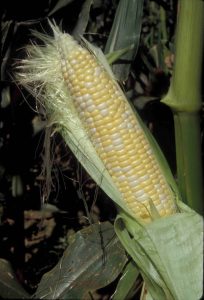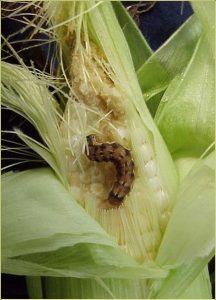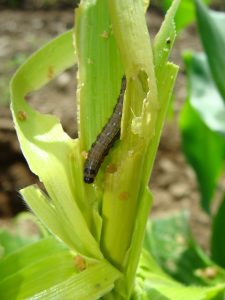Sweet Corn IPM Newsletter No. 12 – September 11, 2017
 Sweet Corn IPM Newsletter No. 12 – September 11, 2017
Sweet Corn IPM Newsletter No. 12 – September 11, 2017
Click on photos to enlarge.
CORN PEST THREAT MODERATE BUT VARIABLE
Corn Earworm and Fall Armyworm Active in Silking Corn at Most Sites
SITUATION
Cool nights and some rainy days appear to be holding corn pests at moderate levels for this time of year, as the sweet corn season winds down. However, we may still have the remnants of tropical storms to deal with over the next couple of weeks which could cause an increase in corn earworm and/or fall armyworm populations. Next week will be the last scheduled issue of the Sweet Corn IPM Newsletter for the 2017 season.
European corn borer: No moth captures this week, suggesting the threat of corn borer may be over for this season. Larval feeding injury on younger corn was also very low, and did not exceed threshold at any location.
Corn earworm: Overall, moth counts remain fairly low this week, but high enough to keep some sites on a tight spray schedule for any fresh silking corn remaining. A 5-day spray schedule was recommended in Auburn, New Gloucester, North Berwick, and Wells. A 4-day spray interval was recommended in Biddeford, Cape Elizabeth, one Dayton location, Lewiston, Monmouth and Sabattus.
- Corn Earworm Feeding on Corn; photo by David Handley
- Fall Army Worm on Pre-tassel Corn; photo by David Handley
Fall armyworm: Moth activity is becoming spottier from site to site, with some locations well over the 3-moth threshold for silking corn, and others seeing few, if any moths. A spray for fall armyworm on silking corn was recommended in one Dayton site, Nobleboro, Poland Spring and Wales. Other sites, including Auburn, Biddeford, Cape Elizabeth, Dayton, Lewiston, Monmouth, North Berwick, and Sabattus were also over the 3-moth threshold, but are on a spray schedule for corn earworm. No sites were over the 15% injury threshold for larval feeding damage in pre-tassel to tassel corn.
Annual end of corn season checklist:
- Plow down corn stalks and stubble to destroy overwintering larvae of European corn borer.
- Plant a cover crop, such as winter rye, to prevent soil erosion and to add organic matter to the soil.
- Take a soil test to determine if lime or other nutrients should be applied.
- Plan to rotate your crops to prevent pests from building up in any one location.
- Evaluate your weed management results. What worked well and what didn’t? Which weeds were the biggest problems? How can you improve control?
- Unplowed Corn Field; photo by David Handley
- Oats Cover Crop; photo by David Handley
The New England Vegetable & Fruit Conference will be held in Manchester, NH on December 12, 13, and 14, 2017. Program and registration information will be coming soon. Visit the website: http://www.newenglandvfc.org/.
Reminder: Free disposal of unusable pesticides
The Maine Board of Pesticides Control (BPC) and the Maine Department of Environmental Protection (DEP) are sponsoring the Obsolete Pesticides Collection Program. This free program is open to homeowners, family-owned farms and greenhouses. Collections of unwanted pesticides will occur at four sites: Presque Isle, Bangor, Augusta, and Portland. Participants must pre-register by September 29, 2017. Drop-ins are not permitted. To register, get details, and learn important information about the temporary storage and transportation of obsolete pesticides, go to the Maine BPC web site or call 207.287.2731.
Sincerely,
David T. Handley
Vegetable and Small Fruit Specialist
Highmoor Farm, P.O. Box 179, 52 US Route 202, Monmouth, ME 04259, 207.933.2100
UMaine Extension Diagnostic Research Lab, Pest Management Unit, 17 Godfrey Drive, Orono, ME 04473, 1.800.287.0279
| Location | CEW Moths |
ECB Moths |
FAW Moths |
%Feeding Damage |
Recommendations / Comments |
|---|---|---|---|---|---|
| Auburn | 5 | 0 | 10 | 5-day spray interval recommended on all silking corn | |
| Biddeford | 8 | 0 | 7 | 4-day spray interval recommended on all silking corn | |
| Bowdoinham | 0 | 0 | 0 | No spray recommended | |
| Cape Elizabeth I | 25 | 0 | 38 | 4-day spray interval recommended on all silking corn | |
| Cape Elizabeth II | 8 | 0 | 17 | 4-day spray interval recommended on all silking corn | |
| Dayton I | 41 | 0 | 107 | 0% | 4-day spray interval recommended on all silking corn |
| Dayton II | 0 | 0 | 5 | One spray for FAW on all silking corn | |
| Lewiston | 15 | 0 | 4 | 4-day spray interval recommended on all silking corn | |
| Monmouth | 12 | 0 | 9 | 4-day spray interval recommended on all silking corn | |
| New Gloucester | 6 | 0 | 0 | 5-day spray interval recommended on all silking corn | |
| Nobleboro | 0 | 0 | 42 | One spray for FAW on all silking corn | |
| North Berwick | 4 | 0 | 3 | 3% | 5-day spray interval recommended on all silking corn |
| Oxford | 1 | 0 | 2 | No spray recommended | |
| Poland Spring | 0 | 0 | 12 | One spray for FAW on all silking corn | |
| Sabattus | 14 | 0 | 7 | 4-day spray interval recommended on all silking corn | |
| Wales | 0 | 0 | 5 | One spray for FAW on all silking corn | |
| Wayne | 0 | 0 | 0 | No spray recommended | |
| Wells I | 5 | 0 | 2 | 5-day spray interval recommended on all silking corn | |
| Wells II | 4 | 0 | 2 | 9% | 5-day spray interval recommended on all silking corn |
CEW: Corn earworm (Only fresh silking corn should be sprayed for this insect.)
ECB: European corn borer
FAW: Fall armyworm
| Moths caught per week | Moths caught per night | Spray interval |
|---|---|---|
| 0.0 to 1.4 | 0.0 to 0.2 | No spray |
| 1.5 to 3.5 | 0.3 to 0.5 | Spray every 6 days |
| 3.6 to 7.0 | 0.6 to 1.0 | Spray every 5 days |
| 7.1 to 91 | 1.1 to 13.0 | Spray every 4 days |
| More than 91 | More than 13 | Spray every 3 days |
Thresholds apply only to corn with exposed fresh silk. Lengthen spray intervals by one day if maximum daily temperature is less than 80°F.
European Corn Borer Thresholds
Whorl stage: 30% or more of plants scouted show injury.
Pre-tassel-silk: 15% or more of plants scouted show injury.
Silk: 5 or more moths caught in pheromone traps in one week.
IPM Web Pages:
UMaine Cooperative Extension Integrated Pest Management
Penn State Pest Watch for Sweet Corn
UMass Amherst Integrated Pest Management
Where brand names or company names are used, it is for the reader’s information. No endorsement is implied nor is any discrimination intended against other products with similar ingredients. Always consult product labels for rates, application instructions and safety precautions. Users of these products assume all associated risks.
The University of Maine is an equal opportunity/affirmative action institution.




